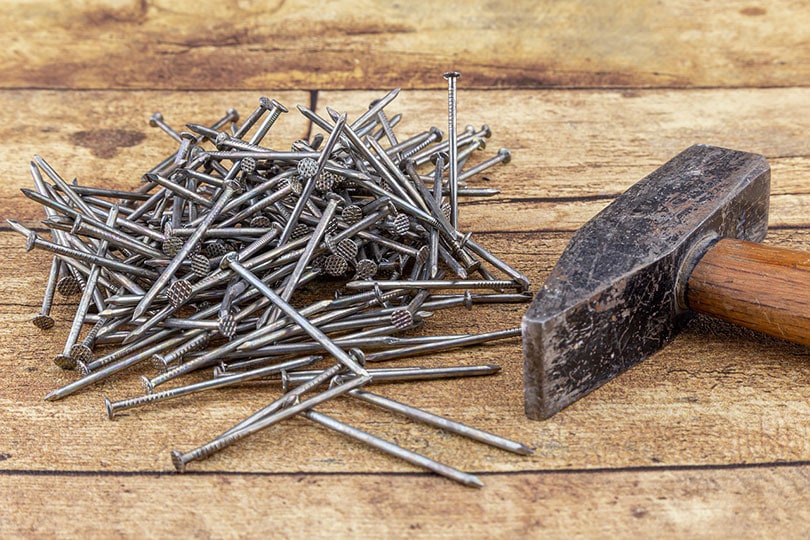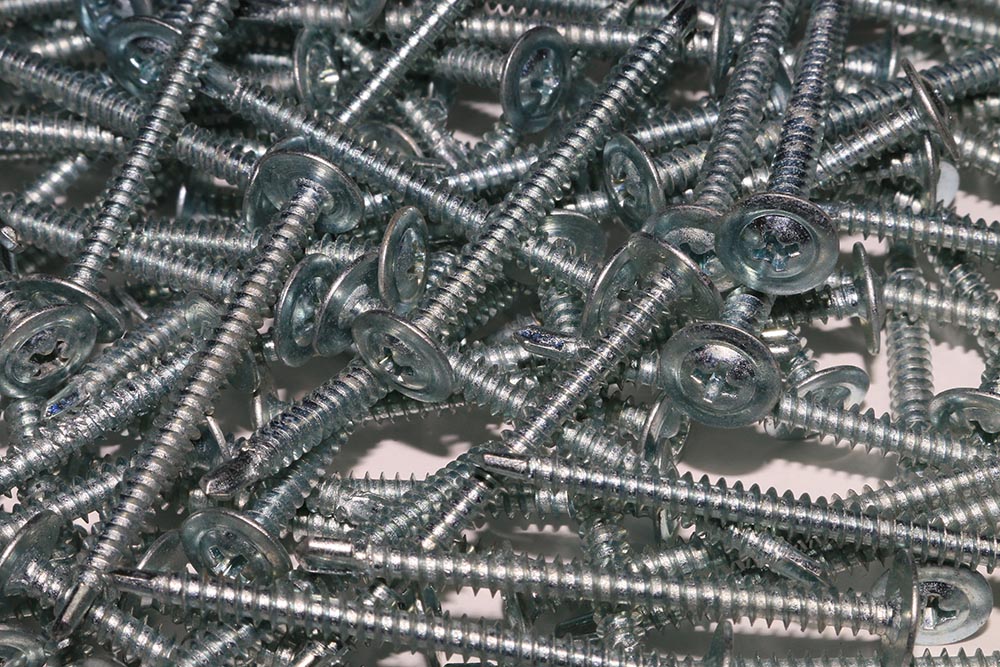Nails vs. Screws: Pros, Cons, & When to Use
-
- Last updated:

When you’re a home improvement novice, it’s easy to overlook the details. It can sometimes take a little research or, failing that, a few bad experiences to teach you why there are so many kinds of saw blades, sandpapers, and virtually any other material you might need for your DIY projects.
When it comes to fasteners, the choice might seem simple and insignificant, but the differences between nails and screws can substantially affect your finished product. The subtleties can sometimes be hard to understand, so we’ll help you make the best choice every time with this breakdown of nails versus screws.

Nails
Nails are smooth, pointed shafts with a flat head that you pound into place with a hammer or nail gun to fasten two or more materials. Compared to screws, nails are less expensive, and with a nail gun, you can install them extremely fast. Nail guns can hold a clip of nails, allowing you to drive them rapidly in succession, while drills typically only fit one screw at a time. You can buy a collated screw gun for speed, but even these can’t match the immediate driving power of a nail gun.

When to Use Nails
Nails are ideal for scaled-up construction projects where the fasteners will be in place permanently, particularly in structural framing and flooring. Beyond speed and efficiency, nails also have a few crucial performance benefits over screws in these situations.
Structural Framing
One advantage of using nails in housing framing is that they can hold more weight and better withstand the shear forces of two objects sliding against each other. When put under stress, they will bend but maintain their integrity. Under the same pressure, screws will more readily snap in half.
In structures where the load is bearing down on itself and constantly withstanding weather forces and foot traffic, nails will keep the framing pieces from separating. It’s against code to use anything other than nails for a house’s framing in many instances.
Trim and Flooring
For aesthetic purposes, you should also choose nails when affixing trim and hardwood flooring. The primary advantage is that you can drive the nail head below the wood surface, hiding the fastener for a clean look. A nail head can be much smaller than a screw head because it doesn’t have to accommodate a drill bit, so the recessed hole is far less conspicuous and easier to mask.

Types of Nails
Nails come in numerous lengths, thicknesses, and styles to cover countless applications, from tiny brads for building birdhouses to heavy galvanized roofing nails. Certain varieties, like masonry nails, are designed for specific materials, while others provide particular aesthetic or practical benefits. For example, handmade cut nails add a decorative early-American element to hardwood flooring.
Ring shank nails are one of the best all-around nails to consider for construction projects. They feature grooved rings below the pointed end. When driven into wood, the wood fills the grooves for a tighter hold and a lower likelihood of the nail backing out over time. Ring shanks work best in softwoods, while another variation, the screw shank, is preferable for hardwoods.
- Fast and easy to install
- Can withstand bending and twisting
- Forceful impact can cause imprecise installation
- Cheaper than screws
- Thinner shaft is less likely to split wood when driven
- Much harder to remove than screws
- Nail guns are more dangerous to operate than impact drills
- Lower tensile strength can cause nailed materials to separate

Overview of Screws
Like a nail, a screw is a narrow shaft with a point on one end and a head on the other that joins two materials together. Instead of being smooth, it features a thread that spirals into the materials as it is driven and creates a sturdy grip. You can attach screws with a powered drill or by hand with a screwdriver, using a twisting motion to insert them.
The head of a screw has a recession that matches the shape of a specific drill bit or type of screwdriver. The most common screw heads have “+” or “– “shapes to fit a Phillips head or flat-head bit. You can also find screws that pair with square, star, or Allen bits. Other screws have combo heads that match multiple bit types, while still more have a bolt head for installing with a nut driver.
Short screws often have a thread covering the entire shaft, but larger screws sometimes feature a bare section below the head. The smooth surface prevents the screw head from driving too far into the top material. When screwing two materials together, the screw spirals into the top material to a point before pulling the bottom material in, creating a fast, tight grip with no gap.

When to Use Screws
Screws have much higher tensile strength (or “grip”) than nails, so they resist two materials pulling apart. While it’s not hard to pry apart two nailed-together pieces of wood with your hands, you’d have a harder time if a screw is holding them in place.
Cabinetry and Temporary Projects
Screws are ideal for situations where materials are under tension or have the force of gravity pulling on them. Kitchen cabinetry is an excellent example, as the shelving and framing constantly feel gravity’s stress. While nails may eventually loosen out of their holes, screws will hold fast for the long term.
Another benefit of screws in smaller projects like cabinets is that they’re easier to remove than nails. You can insert and remove a screw for temporary connections without damaging the joined materials. They’re perfect for pieces you may want to take out and replace at some point to make adjustments, such as door hinges or cover plates.
Decking
Gravity and other external forces aren’t the only things that stress nails and screws. In the case of wood, natural expansion and contraction that occur with temperature fluctuations can pull and push on fasteners.
Minor floorboard movement indoors isn’t an enormous concern if you leave an appropriate expansion gap, and nails will stay put in most cases. But in the elements, deck boards will aggressively pull on their fasteners. High moisture levels from rain and humidity will make the boards want to curl, and temperature changes will cause them to expand. Unless you want to deal with popped nails over and over again, screws are the best choice.
Drywall
Screws are better for wall-hung and ceiling drywall primarily because they are less likely to split the soft gypsum material than a nail impact and are less susceptible to loosening. They form a tight hold between drywall and studs, and you won’t have to deal with pesky nail pops that make you refasten your panels, apply mud, and repaint.
While nail heads are easier to hide below the surface in harder materials, the special shape of drywall screws allows you to compress the head below the drywall surface without damaging the paper cover or gypsum fill. That prevents the drywall from breaking down and popping out away from the stud, effectively ripping past the screw.
To properly set a screw in drywall, you need to use drywall screws with bugle-shaped heads and a drywall screw setting drill bit (or “dimpler”). The bit is a normal Phillips head, but it has a ring around it that prevents the screw from going too far into the drywall. When you screw it in, the circle meets the drywall once the screw head is flush with the wall. The bit countersinks the screw and slightly presses in the drywall around it. The newly formed dimple is then easy to fill with mud so you can hide the screw head.
Subflooring
Screws are an unfashionable option for floorboards, but they’re the perfect solution for subflooring. With plywood laid over and attached to joists, the fasteners are subject to the up-and-down forces that cause nails to wiggle free. By using screws, you create a tight, long-lasting grip that will prevent any unwanted squeaks underfoot.

Types of Screws
There are numerous screws for construction and machining, and like nails, they come in an array of lengths and widths to fit a range of uses. One popular design is a self-tapping screw, which features a groove on the tip that pre-drills the hole, saving time and preventing the material from splitting. You can also find various designs for specific materials, including wood, sheet metal, masonry, drywall, and MDF.
- High tensile strength creates a tight bond and prevents separation
- Easy to remove and better for temporary projects
- Easier to control the driving path
- More time-consuming to install
- Not as flexible as nails and more likely to snap
- Screw heads are more pronounced and challenging to hide
- More likely to split wood

Nails vs. Screws: Does It Matter Which One I Choose?
- Structural framing
- Interior trim work
- Flooring
- Finishing carpentry
- Permanent builds
- Cabinetry
- Drywall
- Decking
- Subflooring
- Temporary builds
In the situations above, choosing one over the other has distinct advantages. Still, there will be times when comparing nails versus screws won’t have an enormous impact. An outdoor fence, for example, can often last years regardless of the fastener you use.
Other projects may require a blend of nails and screws. When building a chair, you may use screws for a fast hold on the legs but use nails to attach thinner wood sections to prevent splitting. For an outdoor deck, it’s often a good idea to use nails for attaching joists to the frame and screws for the deck boards. The decision often comes down to whether you need the fastener to be strong and permanent or tight and easy to remove.
Will Glue Hold Nails in Place Better?
An easy way to improve the tensile strength of nails is to add glue between the two materials. The adhesive will create a minor bond with the fastener and affix the materials for improved shear strength. The nail will generally face less stress due to the tighter bond between the two materials, and it will be less likely to back out because the glue will hold it in place.

Conclusion
It’s incredible how often the tiniest detail dictates the quality of the grandest construction project. In the case of nails versus screws, what seems like a trivial choice can impact the cosmetics and integrity of your build. In worst-case scenarios, that translates to wasted money, extra effort, and even safety issues.
Fortunately, manufacturers make it easy to find the right product for the job by offering a diverse selection. By following the product directions and this guide on when to use nails versus screws, you’ll make the most effective and efficient choice every time.
Featured Image Credit: (L) Camera-man, Pixabay | (R) cocoparisienne, Pixabay
Contents

